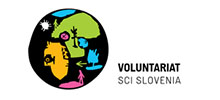Working with people with psychological trauma
This article will cover the aspects of working with people who have experienced trauma and have post-traumatic stress disorder. The article will include the main symptoms that allow recognition of post-traumatic stress disorder and recommendations on how to work with people facing these issues.
This article is written by a person who experienced post-traumatic stress in a war zone. It includes common reactions on trauma and practical recommendations for trauma - informed care based on personal experience of the author.
This article is recommended to be used as a guidance by group leaders, workcamp leaders, youth workers, educationalists working with people who faced trauma. However, this article is not to be seen as a tutorial or a professional training. For professional training on the topic please contact counseling organizations.
What is psychological trauma?
Trauma is an emotional response to a terrible event like e.g. an accident, rape, or natural disaster. Immediately after the event, shock and denial are typical. Longer term reactions include unpredictable emotions, flashbacks, strained relationships, and even physical symptoms like headaches or nausea. (American psychological association)
Psychological trauma is a response to an event that a person finds highly stressful. Examples include being in a war zone, a natural disaster, or an accident. Trauma can cause a wide range of physical and emotional symptoms. ( Medical News Today)
How to recognize psychological trauma symptoms?
In order to recognize psychological trauma symptoms it is important to be aware of common psychological reactions of people who faced trauma issues. In this article we will look through six most common symptoms of post-traumatic stress disorder.
1. Emotional symptoms for post-traumatic trauma might include fear, sadness, anger, shame, anxiety etc. The range of emotions depends on the individual character of a person. When you notice a group member who expresses feelings mentioned above it is important to understand that their feelings most likely are not connected with other participants personally but are the highlighted symptoms of going through the trauma situation.
2. Physical symptoms might include sleep disturbances, somatic complaints (e.g. pain or weakness related to the body), neurological problems etc. In order to help a person with these symptoms it is necessary to act on a physical level. More concrete steps will be given in “How to help people with post-traumatic stress disorder” chapter of this article.
3. Cognitive symptoms might be presented by a negative attitude to daily life, beliefs that the world is not a safe place, people are dangerous etc. A person with cognitive symptoms might misinterpret any current situation as dangerous because it echoes, even remotely, a previous trauma. A person might feel himself or herself as an “alien” in a group of people. Another cognitive symptom includes having flashbacks or triggers: a noise, a smell, physical sensation or a visual scene which might remind a person about a trauma even being outside of that past situation. Examples of a trigger for a person with post war stress symptoms might include a loud noise reminiscent of bombing, explosion or an air alarm, a sound of a plane or helicopter used in military purposes etc. These examples are really individual as they depend on the traumatic situation that happened with a person. One more cognitive symptom includes derealization: long silence, monotonous voice or responses that are not appropriate to context or situation.
4. Behavioral symptoms Behavioral symptoms are recognized by avoidance, compulsive (e.g. overeating) or impulsive (e.g. high risk) behavior, aggressiveness or helplessness when a person is not able to make any decisions. Examples could include drinking alcohol too much or too often, crying in a situation that is not typically emotional, avoiding communication with other people or being too aggressive with them.
5. Social symptoms are mainly represented by a sense of betrayal and absence of trust to other people. Examples might include worrying about meeting new people and starting conversations with them or even going shopping, avoiding social activities or group conversations, feeling of being watched and judged by others, low self-esteem and fear of being criticized by others, avoiding eye contact.
Developmental symptoms include confusion, anger, fear, low performance or withdrawal from the group. Examples could include verbal or physical aggression toward others, feeling insecure with other people or having intense mood shifts.
Symptoms can vary over time but they are constantly repeated. They might be seen when a person is stressed in general or when he or she experiences flashbacks. Symptoms might intensify as a trigger might be in some ordinary situation which is not recognized by others. Once a group leader, campleader or a youth worker is informed about a participant's background or at least knows some general information (e.g. there is war in the country where the participant is coming from), it would add extra awareness and possibility to recognize trauma symptoms.
How to help people with post-traumatic stress disorder?
The following practical steps might be taken by a group leader, campleader or a youth worker in order to minimize the symptoms and support a person.
1. Anxiety survival kit. This preparation step must be taken in advance, before the project takes place on site. Invite a participant with post-traumatic symptoms to create a special box or a bag with different objects that are unique and intimate for him or her. These might be any objects that are related with positive memories (e.g. favorite perfume, a toy or a photo of dear people). At the moment of crisis a person can open their Anxiety survival kit to use it for personal calmness and overcoming anxiety attack. However, if an anxiety attack happens during the project and a participant doesn’t have any specific kit, it’s possible to invite this person to find any really personal thing that he or she has in a bag and that is related to a good memory to help them calm down.
2. Message of hope. It is important to be ready to listen to a person as long as it is needed, focus on him or her talking and accepting their feelings. After that give a “message of hope” - assure a person that he or she is not alone and you are here to help and support as much as it is needed. “Message of hope” is an individually addressed message where a group leader or youth worker recognizes the worries of the participant and helps to concentrate on personal growth that can result from the participants experience. A group leader or youth worker can facilitate this growth by listening to each participant individually. Talking about my personal experience I would recommend using Active listening and simply asking: “How can I help here and now?”
3. Physical exercises. You can organize regular daily physical activities (e.g. yoga, morning exercises) to help to reduce stress symptoms. Meditation and breathing exercises are of great help. Here are examples of simple breathing exercises that can be effectively used: here , here or here.
4. Learn triggers. Avoid loud noises, arguments or sudden movements as they all can be triggers for trauma. Once a participant feels triggered, there is a technique that will definitely help them to refocus attention and calm down, inspiration here.
5. Respect privacy. As it was mentioned earlier in this article, active steps that are taken by a group leader, workcamp leader or a youth worker might help a person with post-traumatic symptoms. However, it is necessary to remember that some people need their privacy to overcome a stress situation or an anxiety attack. So if a person is not ready to share the details of what he or she has gone through, it is their right which needs to be respected.
Author
Written by Kateryna Zolotarova
Kharkiv, Ukraine, 2023













